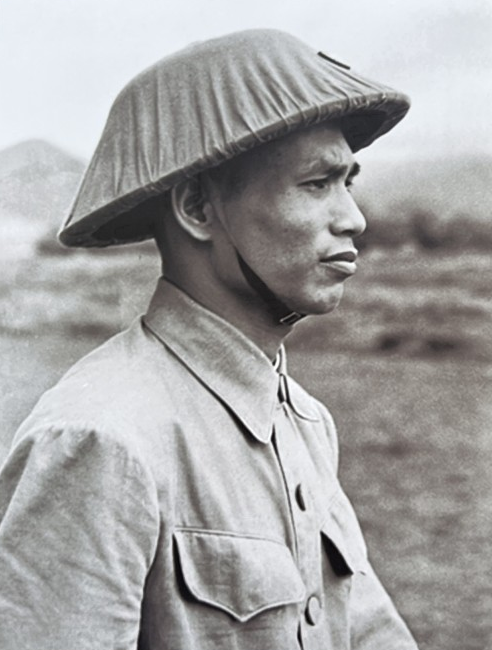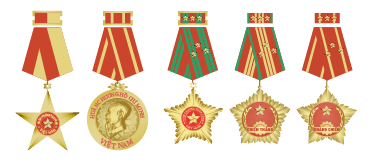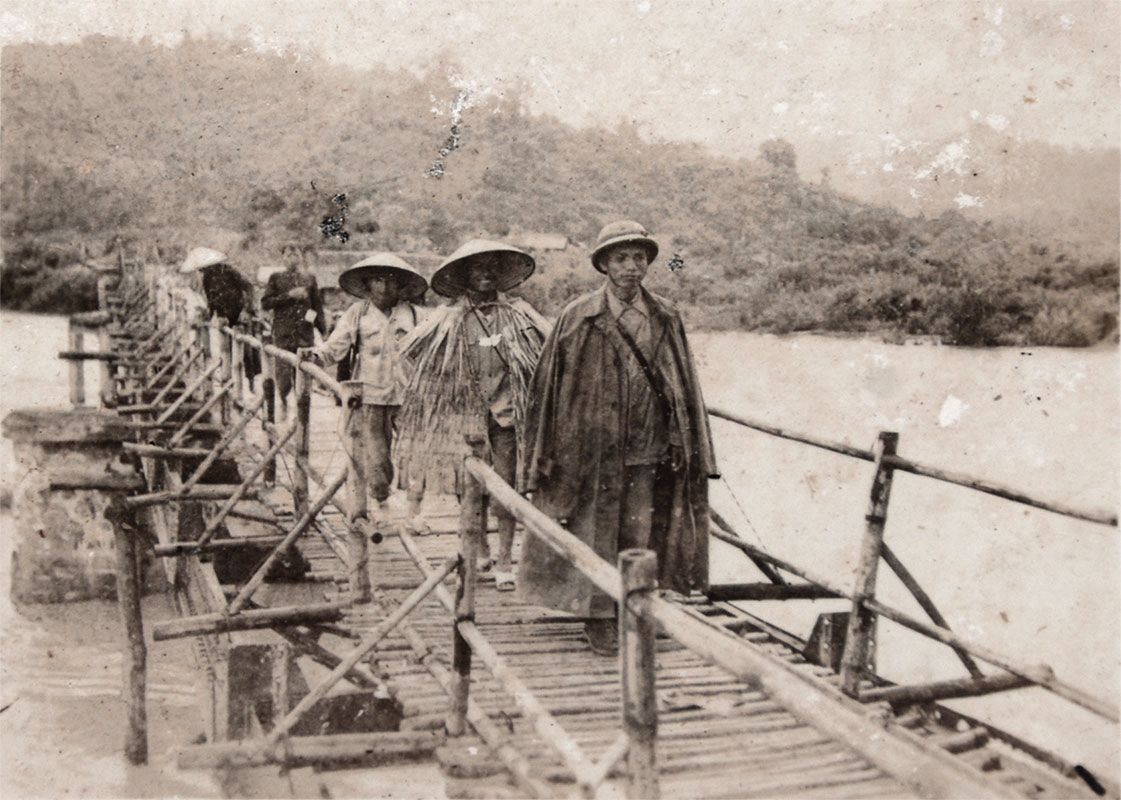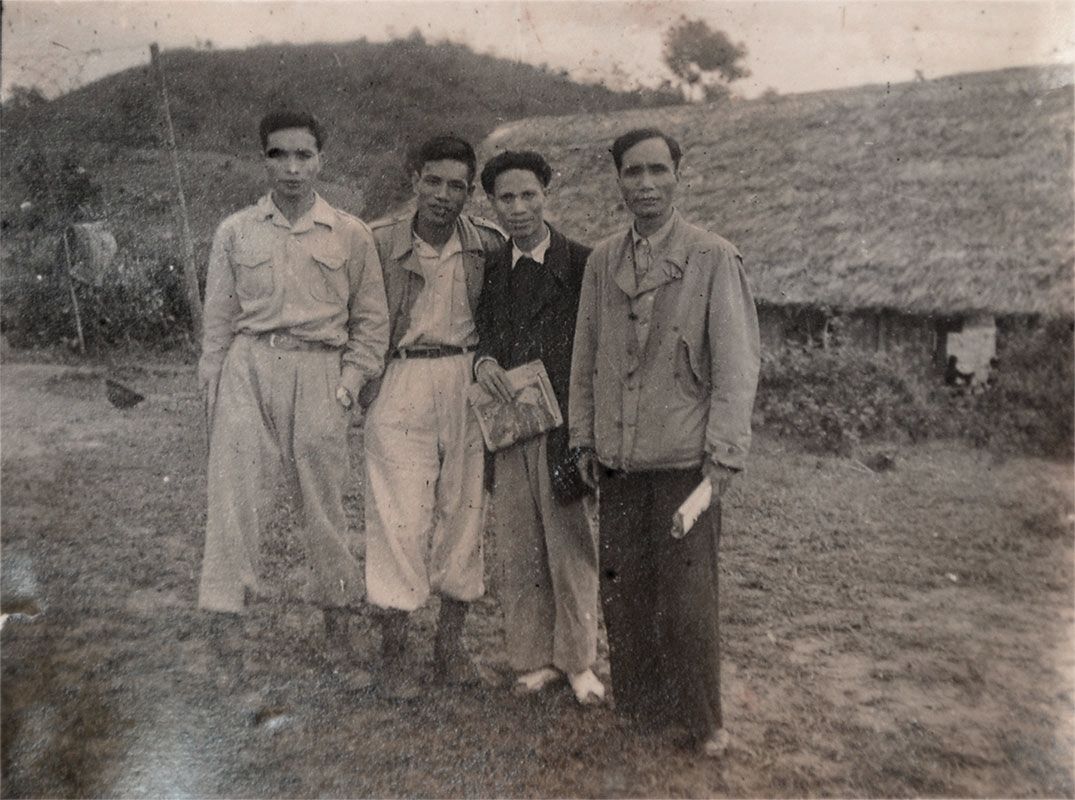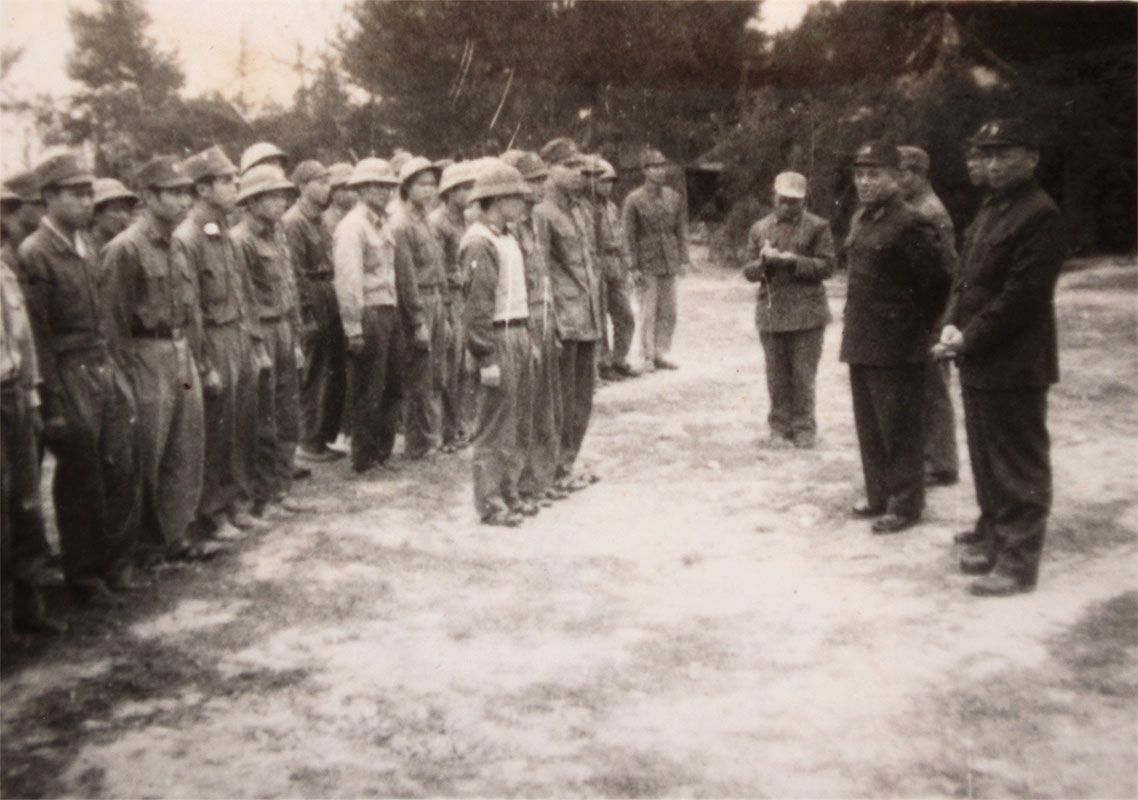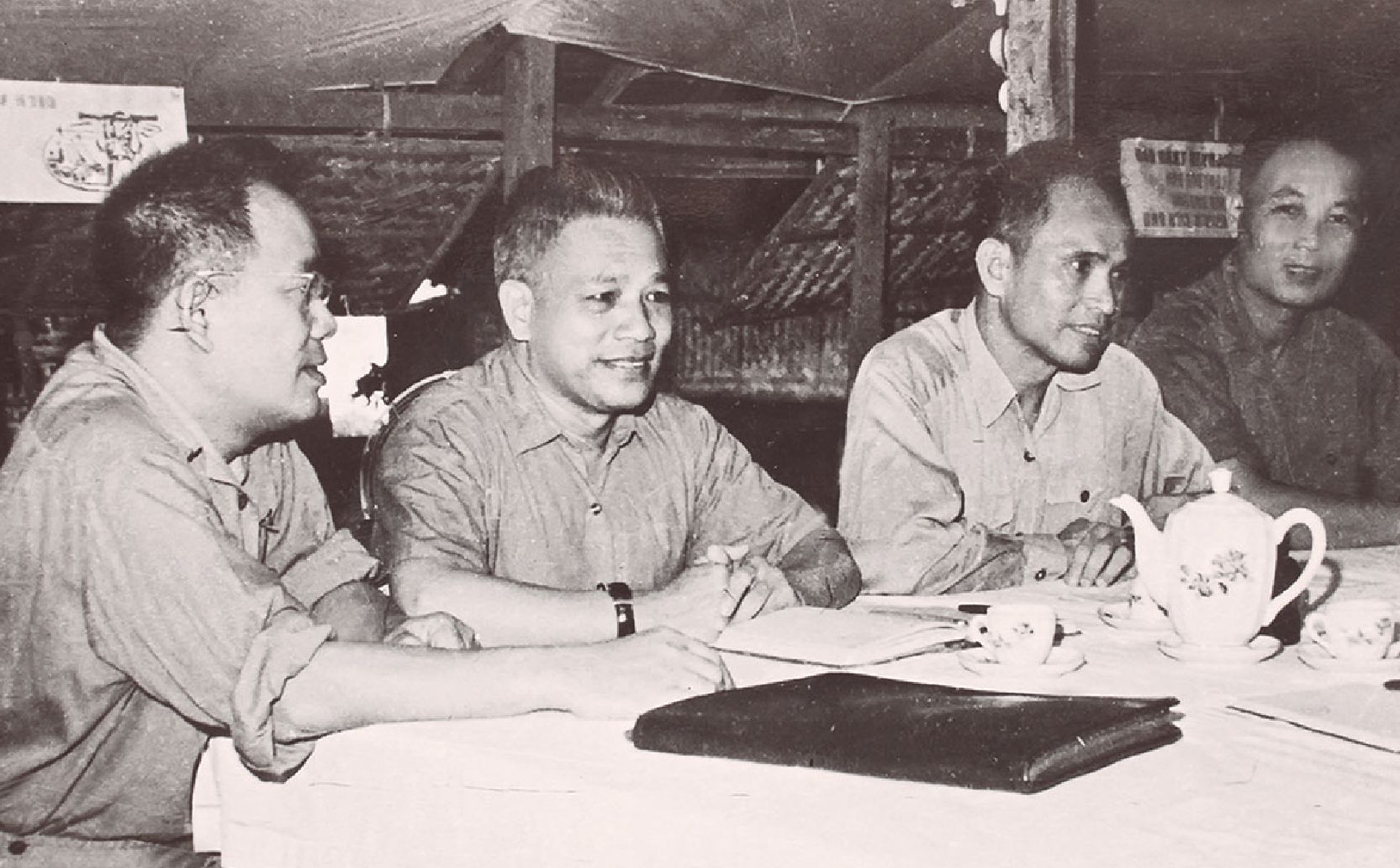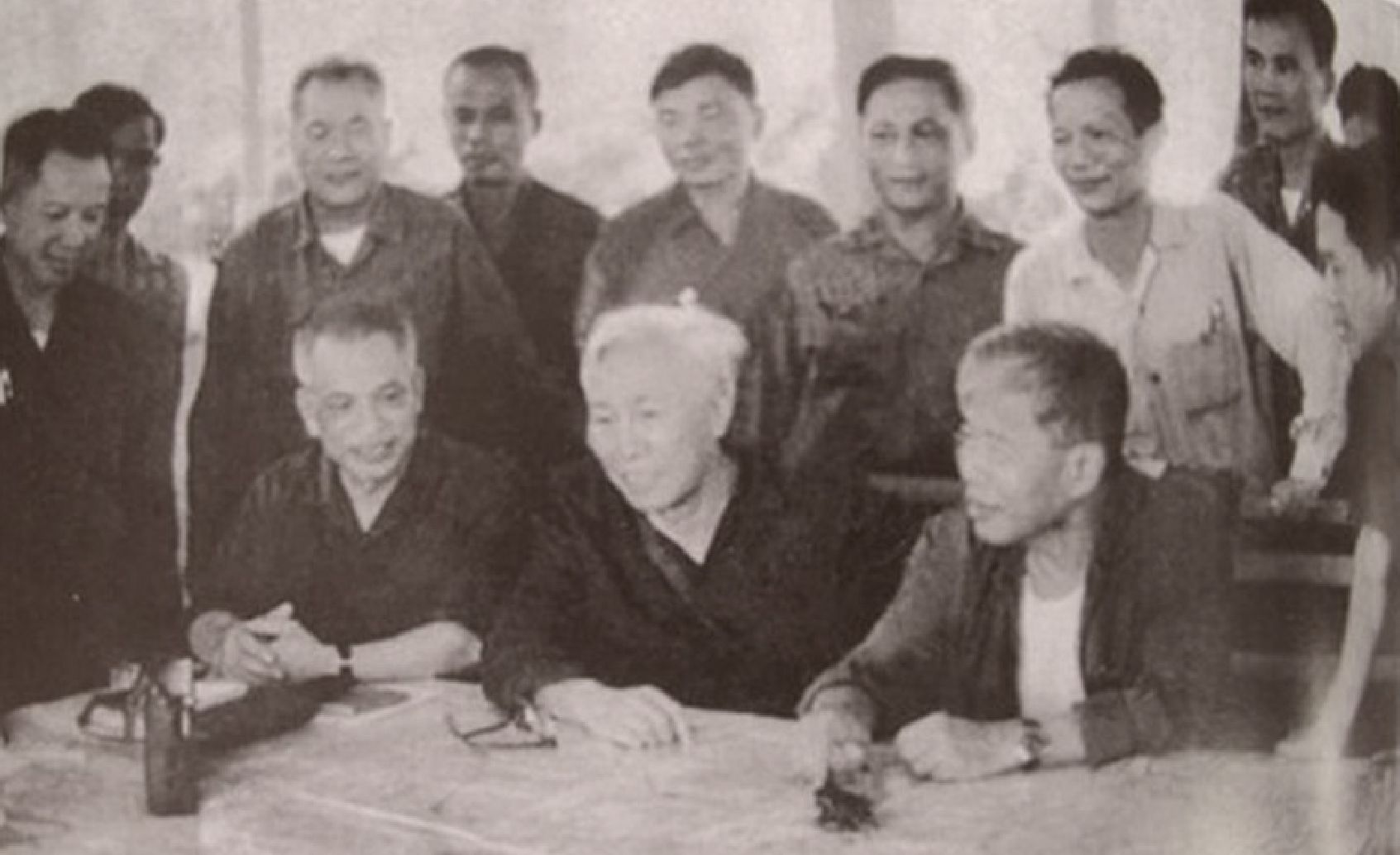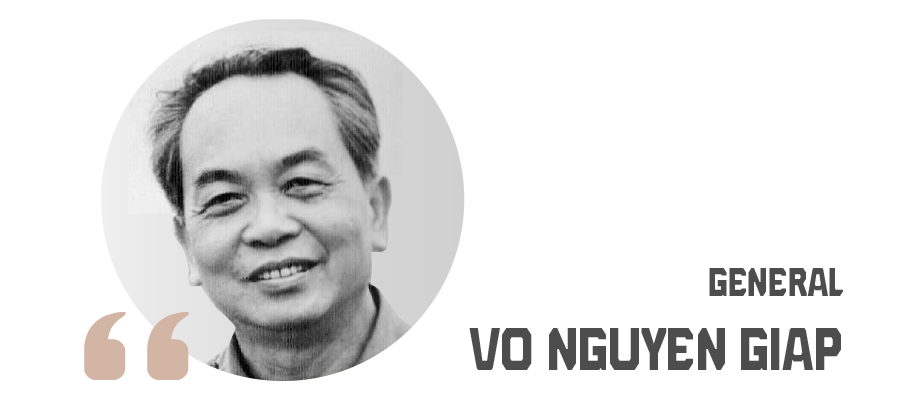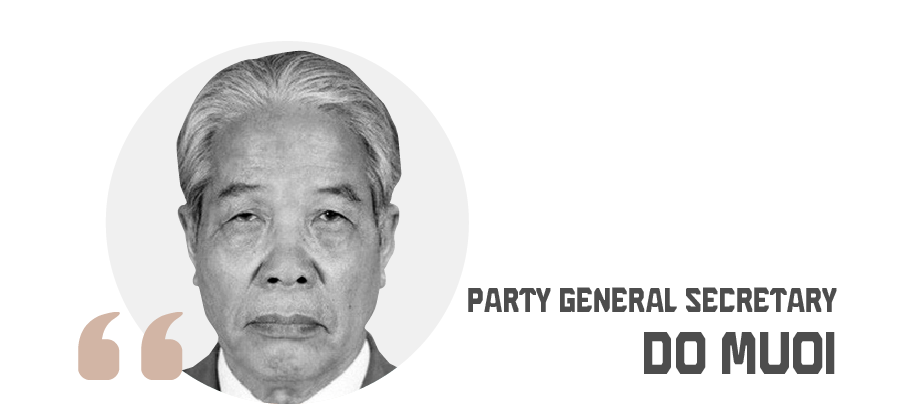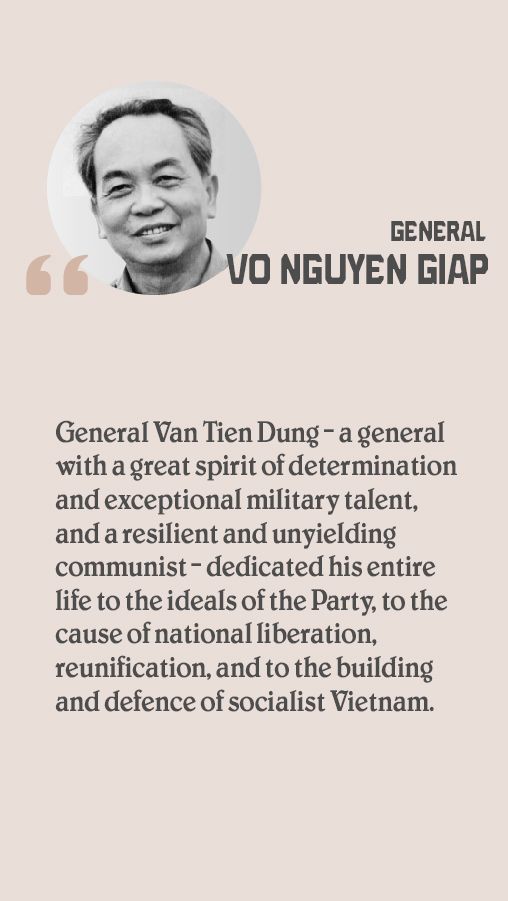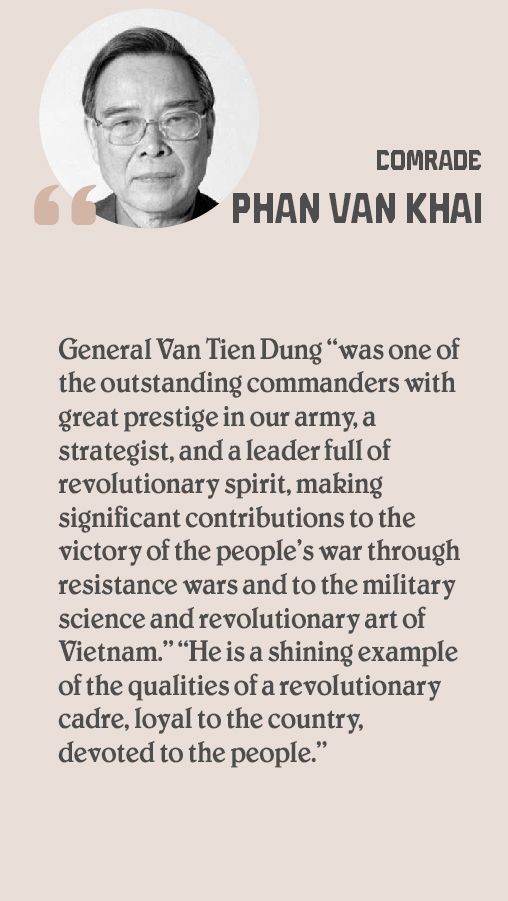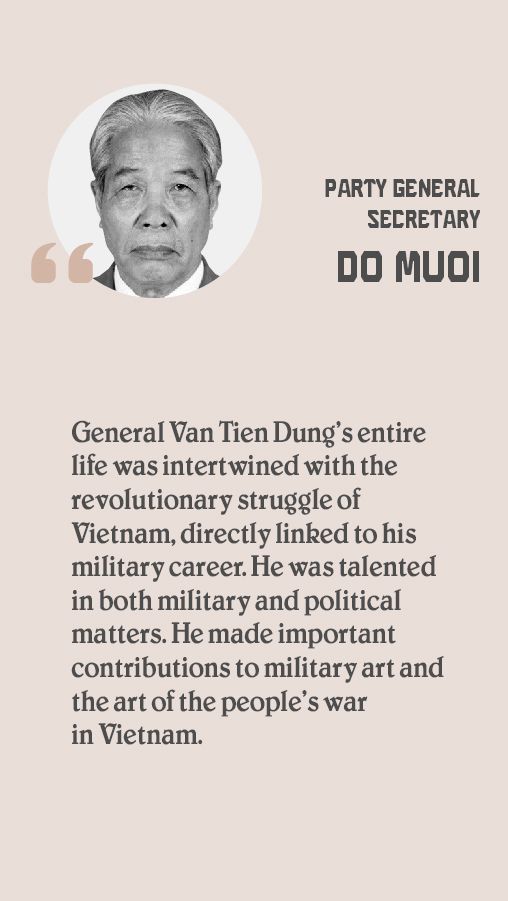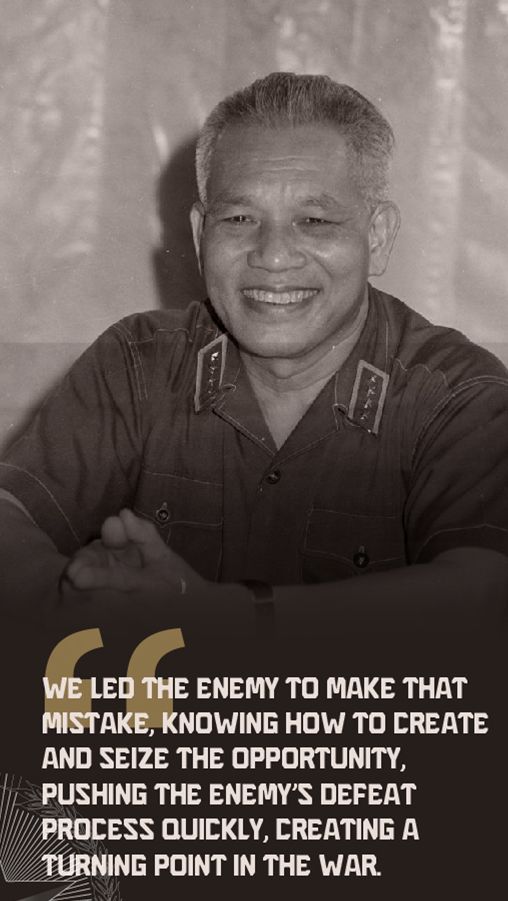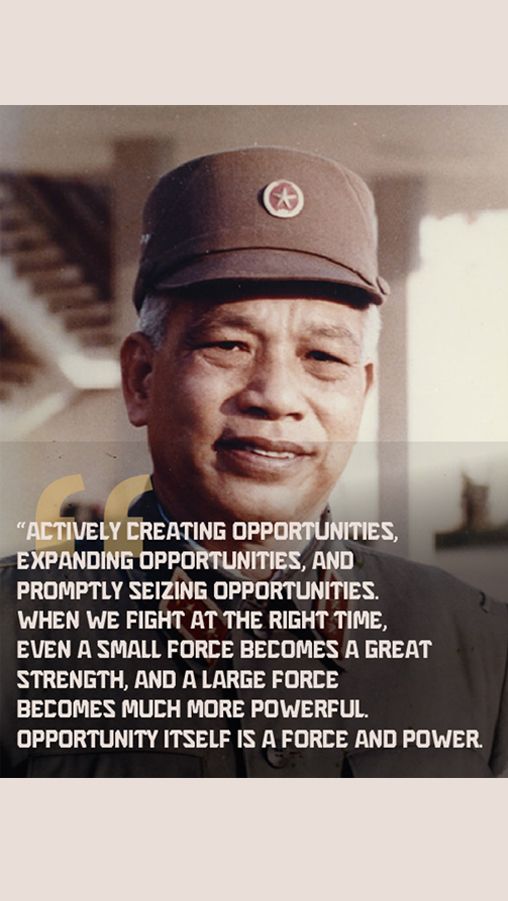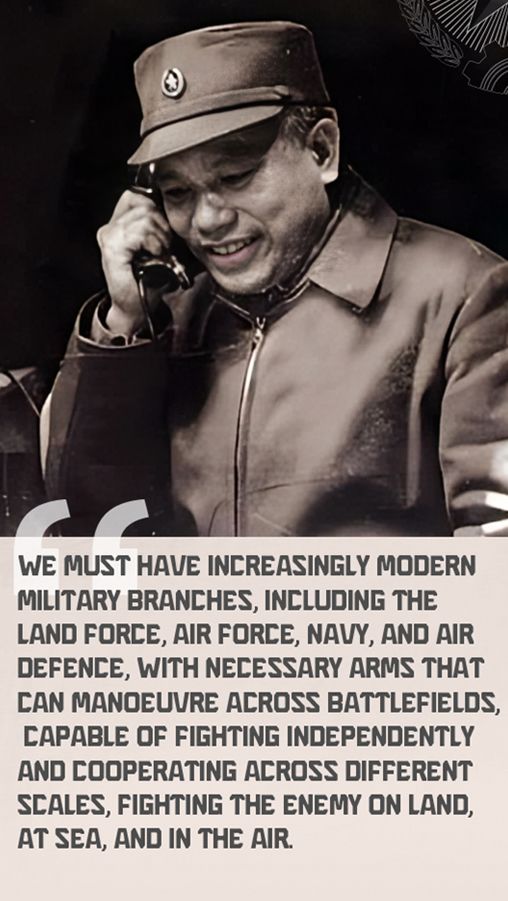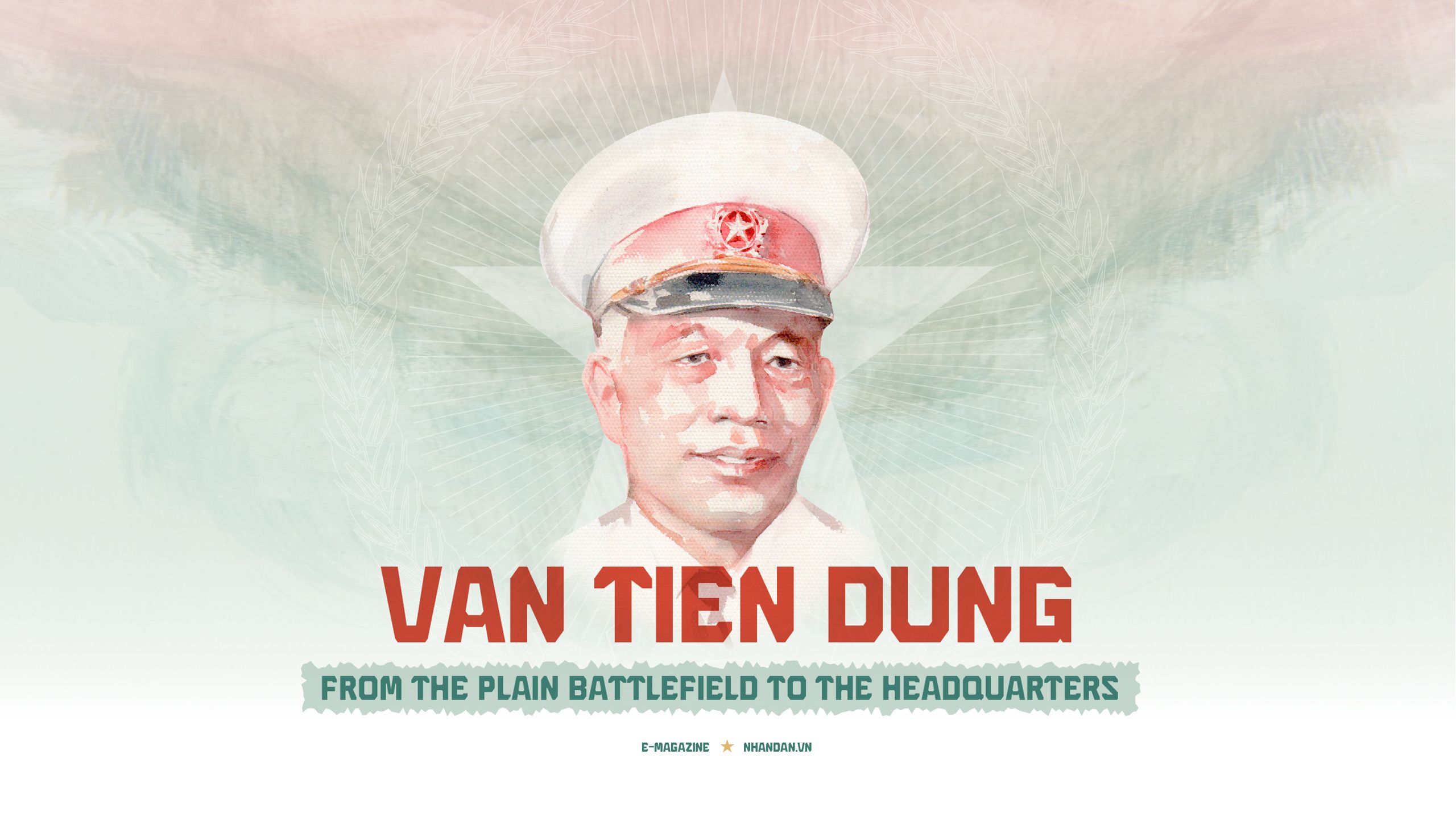
General Van Tien Dung - a typical senior leader of the Party and State, a strategic general, both literary and martial, loyal to the country and devoted to the people, made many important contributions to the struggle for national liberation, building and defending the Fatherland, contributing to supplementing and developing the science and art of revolutionary military in Vietnam in the Ho Chi Minh era. After more than 65 years following the Party participate in revolutionary activities, General Van Tien Dung has continuously held the important position of alternate member and official member of the Politburo of the Party Central Committee (1960 - 1986), 25 years as Chief of the General Staff of the Vietnam People’s Army (1953 - 1978) and many years as Deputy Secretary of the Central Military Commission, Secretary of the Central Military Party Committee (now the Central Military Commission) and Minister of Defence. His life and revolutionary career are closely linked to the struggle for national liberation, the construction and protection of the Socialist Republic of Vietnam, especially the process of fighting, building and growing the Vietnam People’s Army.
Biography of General Van Tien Dung
Van Tien Dung (alias Le Hoai) was born on May 2, 1917, in Co Nhue Commune (now Co Nhue 2 Ward), Bac Tu Liem District, Hanoi City. Born in 1936 and raised in a land of a thousand years of culture, rich in the tradition of revolutionary struggle, he participated in the democratic movement and public struggles of workers in Hanoi City. When he turned 20, he was honoured to be admitted to the Indochinese Communist Party (November 1937). From here, he became increasingly active in the workers’ movement and was imprisoned three times by the French colonialists. However, the colonial regime’s prisons, along with the enemy’s brutal tortures, could not subdue the communist spirit and resilience. He escaped twice, successfully found ways to contact the party organisation, and continued his activities.

Major General Van Tien Dung in 1954
Major General Van Tien Dung in 1954
After the August Revolution of 1945 succeeded, he was appointed to hold the position of Political Commissar of War Zone 2. In November 1946, he was assigned the task of Deputy Director and then Director of the Political Department (the predecessor of the General Political Department of the Vietnam People’s Army today) and Deputy Secretary of the Central Military Commission. In his new position, he laid the foundation for party work and political work in the army, strengthening the Party’s leadership over the people’s armed forces.
During the resistance war against French colonialism, he was assigned as Political Commissar, then Commander of the Inter-Zone, Standing Committee of the Zone 3 Party Committee (October 1949), Political Commissar and Commander of the 320th Division (1951), leading the 320th Division to gradually gain important victories, expand many free zones, and build many guerrilla bases. With the qualities of a strategic and decisive military commander, in November 1953, Van Tien Dung was assigned by the Party Central Committee and President Ho Chi Minh to be the Chief of the General Staff of the Vietnam People’s Army and to participate in the General Military Commission. He and the General Military Commission and the General Command advised and organised the implementation of the Winter-Spring 1953-1954 combat plan, culminating in the Dien Bien Phu Campaign of 1954, bringing the resistance war against French colonialism to a victorious end.
After the resistance war against the French colonialists ended, he devoted his time and energy to advising the Central Military Commission and the Ministry of Defence to build the Vietnam People’s Army into a regular army with three branches: Army, Air Defence - Air Force and Navy, contributing to building and consolidating the national defence to protect the socialist North and being ready to fight to liberate the South. When the US imperialists escalated the war, directly sending expeditionary troops to invade the South and sending air force and navy to attack the North, he and the Central Military Commission and the General Command directly commanded the forces to defeat the US imperialists’ “war of destruction” in the North and the war strategies they applied in South Vietnam. Especially in the Ho Chi Minh Campaign (April 1975), by fighting with the strong ideology of “boldly penetrating deep combined with flanking and strong breakthroughs from the outside”, he contributed significantly to the Great Victory of Spring 1975, liberating the South and unifying the country.
After peace was restored and the country unified, Comrade Van Tien Dung joined members of the Central Military Commission and the leaders of the Ministry of Defence to advise the Party and State on realising the political and military guidelines of the Party; gradually building a comprehensive strategy for national defence, strengthening the people's defence forces, establishing a people's war framework, and developing armed forces that involve a combination of military, paramilitary, and civilian forces; directing the implementation of many sound policies and solutions regarding military tasks, national defence, and border protection along the Southwest and Northern borders; and fulfilling international obligations while firmly safeguarding the socialist homeland of Vietnam in all situations.
From his battlefield experience and in response to mission requirements in the new situation, he continued to participate in directing and organising research, completing numerous projects summarising the two resistance wars against French colonialism and American imperialism, as well as studies on the Vietnamese revolutionary war. These projects contributed to affirming the significance of the victories and summarising the valuable lessons learned for application in building a strong people's defence and a revolutionary, disciplined, elite, modern Vietnamese army, thereby firmly protecting the socialist homeland of Vietnam.
For his significant contributions to the struggle for national liberation and protection, General Van Tien Dung was awarded the Golden Star Order, Ho Chi Minh Order, and many other prestigious accolades.
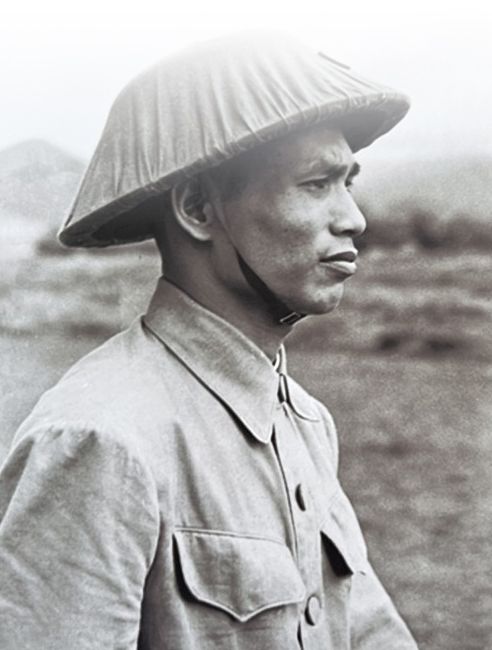
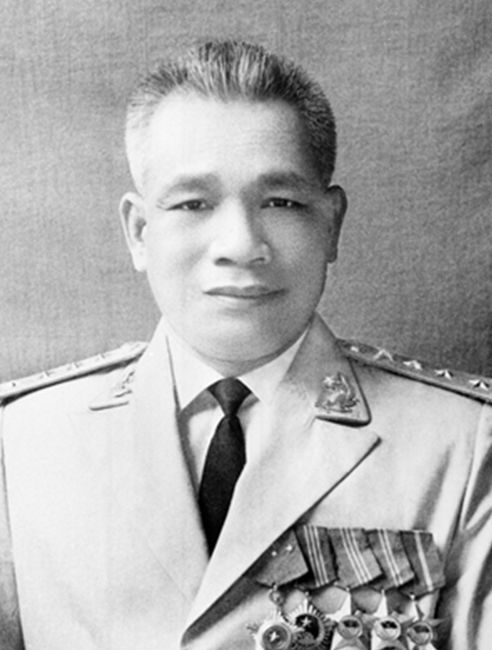
After the August Revolution of 1945 succeeded, he was appointed to hold the position of Political Commissar of War Zone 2. In November 1946, he was assigned the task of Deputy Director and then Director of the Political Department (the predecessor of the General Political Department of the Vietnam People’s Army today) and Deputy Secretary of the Central Military Commission. In his new position, he laid the foundation for party work and political work in the army, strengthening the Party’s leadership over the people’s armed forces.
During the resistance war against French colonialism, he was assigned as Political Commissar, then Commander of the Inter-Zone, Standing Committee of the Zone 3 Party Committee (October 1949), Political Commissar and Commander of the 320th Division (1951), leading the 320th Division to gradually gain important victories, expand many free zones, and build many guerrilla bases. With the qualities of a strategic and decisive military commander, in November 1953, Van Tien Dung was assigned by the Party Central Committee and President Ho Chi Minh to be the Chief of the General Staff of the Vietnam People’s Army and to participate in the General Military Commission. He and the General Military Commission and the General Command advised and organised the implementation of the Winter-Spring 1953-1954 combat plan, culminating in the Dien Bien Phu Campaign of 1954, bringing the resistance war against French colonialism to a victorious end.
After the resistance war against the French colonialists ended, he devoted his time and energy to advising the Central Military Commission and the Ministry of Defence to build the Vietnam People’s Army into a regular army with three branches: Army, Air Defence - Air Force and Navy, contributing to building and consolidating the national defence to protect the socialist North and being ready to fight to liberate the South. When the US imperialists escalated the war, directly sending expeditionary troops to invade the South and sending air force and navy to attack the North, he and the Central Military Commission and the General Command directly commanded the forces to defeat the US imperialists’ “war of destruction” in the North and the war strategies they applied in South Vietnam. Especially in the Ho Chi Minh Campaign (April 1975), by fighting with the strong ideology of “boldly penetrating deep combined with flanking and strong breakthroughs from the outside”, he contributed significantly to the Great Victory of Spring 1975, liberating the South and unifying the country.
After peace was restored and the country unified, Comrade Van Tien Dung joined members of the Central Military Commission and the leaders of the Ministry of Defence to advise the Party and State on realising the political and military guidelines of the Party; gradually building a comprehensive strategy for national defence, strengthening the people's defence forces, establishing a people's war framework, and developing armed forces that involve a combination of military, paramilitary, and civilian forces; directing the implementation of many sound policies and solutions regarding military tasks, national defence, and border protection along the Southwest and Northern borders; and fulfilling international obligations while firmly safeguarding the socialist homeland of Vietnam in all situations.
From his battlefield experience and in response to mission requirements in the new situation, he continued to participate in directing and organising research, completing numerous projects summarising the two resistance wars against French colonialism and American imperialism, as well as studies on the Vietnamese revolutionary war. These projects contributed to affirming the significance of the victories and summarising the valuable lessons learned for application in building a strong people's defence and a revolutionary, disciplined, elite, modern Vietnamese army, thereby firmly protecting the socialist homeland of Vietnam.
For his significant contributions to the struggle for national liberation and protection, General Van Tien Dung was awarded the Golden Star Order, Ho Chi Minh Order, and many other prestigious accolades.
Notable achievements of General Van Tien Dung
1. Dual roles as Political Commissar and Division Commander
The victory at the Border Campaign in 1950 resonated throughout the military and people. After this victory, several comrades were summoned to the General High Command to attend a conference on reviewing the campaign.
At the end of this meeting, the Party Central Committee assigned the Regional Committee and Command of Region 3 to establish a main division operating in enemy-occupied territories. In January 1951, Major General Van Tien Dung was tasked with forming Division 320 (the Delta Division). He was advised by General Vo Nguyen Giap to start building this division immediately to coordinate with an upcoming campaign planned for early 1952.
Alongside General Giap's advice, he also received President Ho Chi Minh's guidance: “Remember that politics is equal to military action. To defeat the enemy, you must win over the people’s support. If you win battles, discipline must be strict — especially with civilians. Do not hesitate to do what you can for the people. The people’s support is everything. Military action must take offensive. If you don't understand your enemy or yourself, don't engage in battle. Once you grasp the situation well, be decisive, bold, and proactive.”
On January 16, 1951, in Mong La Forest in Nho Quan District, Ninh Binh Province, Division 320 — one of Vietnam's first six main divisions — was established. In its early days, amid shortages in personnel and equipment as well as weaknesses in tactics and techniques, many questions arose: How to organise training? What equipment was needed? Where and how would operations take place? To address these challenges promptly, Van Tien Dung convened a conference for the division's Party Committee to establish a new principle: “Fight while building; use whatever forces we have; employ whatever weapons we possess.”
Although Division 320 had only four battalions with insufficient personnel and arms, to encourage soldiers’ mood and meet demands for victory in the first battle, they chose to launch their first campaign in the northwest sector of Son Tay town. This area connected the Viet Bac region with Region 3 and served as a “shield” for Northwest Hanoi. The division's Party Committee assessed that although enemy forces here were stronger than Vietnamese forces and their defences somewhat solidified, there were many vulnerabilities in their defensive positions, and Vietnamese forces had never appeared in this area before which made the enemy complacent. The enemy’s outer belt was strong but their inner network of posts was weak and thin; an aggressive attack would create surprise, and initial heavy assaults would make the enemy easily collapse significantly.
Realising that the enemy's defence had revealed weaknesses, Van Tien Dung ordered the officers and soldiers of the 320th Division to take advantage of the day and night, hastily preparing to set off with a strong belief and the slogan: "Must win the first battle, win the first campaign". He and his soldiers marched with the Thang Long Regiment, the main unit attacking the enemy on Highway 11 in the North of Son Tay, from the town to Trung Ha. Passing through the outposts and watchtowers, Vietnamese soldiers quietly and secretly infiltrated deep into the enemy's rear, quickly occupying the battlefield. In just one night, we completely destroyed nine enemy outposts and fought several more ambushes against reinforcements. The victory in Son Tay, although small, was a great leap forward for the 320th Division. Among the many goals achieved, the greatest gain was winning the hearts of the people. The people trusted and loved the troops, and the troops trusted and loved the people, just as Uncle Ho had instructed. For Van Tien Dung, this was the first challenging step when the Party and Uncle Ho sent him to take part in the Party's military career.
On March 20, 1951, the Division received orders to continue to fight, coordinating with local army units in Son Tay province in the Hoang Hoa Tham Campaign (also known as the Route 18 Campaign, which took place from March 23 to April 7, 1951). In this battle, the Division Command decided to change the secret combat plan, quickly advancing deep into the temporarily occupied enemy area, destroying several vulnerable enemy positions and then quickly withdrawing troops. On the night of March 24, 1951, the Division opened fire and destroyed the Cau Troi, Lai Khanh, and Ngoc Tao posts, threatening and wearing down the two Go Gai and Phu Oc outposts in Son Tay Town. The battles of the 320th Division in Son Tay contributed to attracting two enemy mobile divisions, creating conditions for units to attack the enemy on Highway 18.
The Quang Trung Campaign (also known as the Ha Nam Ninh Campaign, May 28 - June 20, 1951) was the first time that three main divisions (304, 308, 320), local troops and guerrillas simultaneously fought the enemy. With the guiding ideology of constantly attacking and the method of infiltrating and operating deep inside the enemy, the soldiers of the 320th Division under the command of Van Tien Dung closely and smoothly coordinated with local troops and guerrillas of Ha Nam and Nam Dinh provinces to continuously attack the enemy, continuing to win victories.
Next, to coordinate with the main front of Hoa Binh, Major General Van Tien Dung and the commander of the 320th Division decided to attack Phat Diem Town - a solid stronghold (including ten positions) located deep in the enemy's safe rear base. With a surprise attack, after only one night, Vietnamese soldiers took control of Phat Diem. Promoting this victory, within the next half month, the local people's war movement developed strongly, most of Yen Mo District and part of Kim Son District were liberated, and the guerrilla zones were firmly consolidated and expanded.
After the victories in Ninh Binh, the Commander of the 320th Division decided to advance to the left bank of the Red River, turning the enemy's rear into the Vietnamese soldiers' front line. This liberated large areas in the delta and brought the people's war in the delta to a new level. From here, the 320th Division went deep into the enemy's rear, staying to build up forces and fight. This decision was extremely bold but extremely creative for the Party Committee of the 320th Division and Van Tien Dung personally.
During the time in the Northern Delta battlefield, the main force of the 320th Division coordinated with the 304th Division and the local troops of Inter-Zone 3 to build and fight, together with the local armed forces to defeat the Opération Bretagne (December 1, 1952 - January 4, 1953) of the five enemy mobile corps in Nam Dinh. Meanwhile, Regiment 52 of the 320th Division coordinated with Regiments 57, 66, and 9 of the 304th Division and local troops, militia and guerrillas to fight the enemy in Ninh Binh, Nam Dinh, and Thai Binh, eliminating hundreds of enemy soldiers, preserving our forces, and holding the base area. While fighting, the units took advantage of political and military training, focusing on major techniques and guerrilla tactics, drawing experience from anti-sweep operations. After the 1952-1953 Winter-Spring campaign, the main divisions returned from the battlefield to Vietnamese soldiers' rear-liberated areas. The 320th Division from the enemy's rear in Ha - Nam - Ninh gathered in the southwestern liberated areas of Ninh Binh and Thanh Hoa province. In June 1953, the Party Committee of the 320th Division deployed a political training session.
With his military talent proven through many years of service, especially outstanding achievements on the Northern Delta battlefield after becoming Political Commissar and Commander of the 320th Division, in November 1953, Major General Van Tien Dung was appointed by the Politburo as Chief of the General Staff of the Vietnam People’s Army and was added to the General Military Commission.
Thus, in just 34 months (January 1951 – November 1953) as Political Commissar and Division Commander, Van Tien Dung commanded the 320th Division in eight major and minor campaigns, including campaigns that created significant changes, such as the Hoa Binh Campaign and the Ninh Binh Southwest Campaign. On the delta battlefield and with the 320th Division, Van Tien Dung developed his outstanding military talent, commanding troops to defeat many large-scale sweep operations by French colonial mobile units.
2. 25 consecutive years serving as Chief of the General Staff of the Vietnam People’s Army
At the end of 1953, as the Vietnamese people’s resistance against French colonialists entered its most intense phase, Van Tien Dung was appointed by the Party Central Committee as Chief of the General Staff of the Vietnam People’s Army, joining the General Military Commission in November 1953. Assuming the position of Chief of General Staff at this decisive moment in the resistance against the French, Major General Van Tien Dung effectively managed the General Staff in carrying out its duties and responsibilities in the final strategic battle, creating the Dien Bien Phu Victory that “resounded across five continents and shook the earth”, forcing the French government to sign the Geneva Accords. In July 1954, he was appointed the head of the delegation representing the High Command of the Vietnam People’s Army at the Trung Gia Conference. At this conference, Van Tien Dung, together with other delegation members, engaged in direct negotiations with the French delegation, reaching agreements on procedures and measures for the ceasefire throughout Indochina, prisoner exchange, troop regrouping, and the establishment of the central and local joint committees.
During the resistance war against America, he worked alongside the Party Central Committee, Central Military Commission, and Ministry of Defence to direct and organise the General Staff, localities and armed forces in the north to quickly transition to combat readiness, strengthen and develop the army’s forces and equipment, especially new military branches and services; and organise forces and equipment to be sent to battlefields in southern Vietnam and Laos.
He also helped prepare the organisational structure and transformed all activities in the North from peacetime to wartime operations, based on closely combining economic and defence needs, arranging forces to fight and maintain production while mobilising human and material resources for the war effort. Simultaneously, he was engaged in preparing the people’s war position across both North and South to be ready to counter when the Americans expanded the war to the North.
Historical reality has proven that the policies set forth by the Central Military Commission and Ministry of Defence, to which Van Tien Dung made great contributions, played an important role in creating victory for the military and people of the North in countering America’s destructive war, culminating in the “Dien Bien Phu in the Air” Victory in 1972.
In the southern battlefield, when America brought troops en masse into the war zones, Van Tien Dung, together with the Central Military Commission and Ministry of Defence, proposed to the Politburo numerous timely strategic and tactical policies, especially organising and building mobile units at the regiment and division levels stationed in strategic areas in the southern battlefield. These units combined with the people’s war combat methods to defeat American forces, the Saigon army, and US allied forces, leading to the failure of various war strategies that America employed in southern Vietnam.
After liberation day, in his position as Chief of the General Staff of the Vietnam People’s Army, General Van Tien Dung continued to make great contributions in directing the people’s armed forces and people’s army to participate in consolidating newly liberated areas, gradually overcoming the consequences of war and implementing the tasks of building the people’s army, strengthening national defence, and fighting to protect Vietnam’s southwestern and northern borders.
Thus, for 25 years as the Chief of General Staff of the Vietnam People's Army (1953–1978), General Van Tien Dung stood by the nation through the most difficult and fierce years of the war for independence and national sovereignty. He was a loyal, virtuous, and devoted Chief of General Staff who was dedicated to the country and respectful of the people.
General Van Tien Dung visits the Hanoi missile unit in 1972.
General Van Tien Dung visits the Hanoi missile unit in 1972.
General Van Tien Dung at the Air Defence - Air Force Command Headquarters (Hanoi, 1972)
General Van Tien Dung at the Air Defence - Air Force Command Headquarters (Hanoi, 1972)
3. Creating the tactic of "blossoming in the enemy's heart"
Through secret and bold tactic, with striking deep into the enemy's rear, Comrade Van Tien Dung was considered the initiator of the tactic of "blossoming in the enemy's heart". In January 1951, during the first battle of Division 320, which was tasked to cooperate with the Central Highlands Campaign of the General Staff, with a spirit of active offense and with only 3 out of the 4 battalions newly gathered, Comrade Van Tien Dung led the units secretly from the foot of Ba Vi Mountain, passing through many outposts, watchtowers, and enemy-controlled villages, deep into the enemy's rear. They captured the battlefield swiftly and secretly, launching a surprise attack on the Northwest sector of Son Tay Town — a place with a well-established defensive system, strong outer defences, and fortified positions held by European and African troops. However, the system of outposts inside was weak, and the enemy was complacent, thinking, "Even if the Viet Minh's main force grows wings, they cannot get through here." That very night, the troops and local militia worked together to eliminate 9 enemy outposts.
In late 1951, while undergoing training in Thanh Hoa, Division 320 was assigned the mission to coordinate with the main front of the Hoa Binh Campaign. The division promptly marched to the Red River Delta region, launching a secret, bold, and unexpected penetration deep into enemy-held areas in Phat Diem of Ninh Binh Province. Recognising Phat Diem as the enemy's headquarters in a Catholic stronghold — a fortified and treacherous cluster of defences characterised by a complex network of canals and dikes, and a safe rear base deep within their outer defensive corridor — Vietnamese forces launched an attack on the night of December 20, 1951. The units traversed over 20 kilometres of enemy-dense outposts, rivers, and swamps before launching a surprise assault. Within just a few hours of combat, our troops annihilated and dismantled 10 large and small strongholds and subsequently wiped out the enemy's entire reinforcement force. Upholding this victory, Vietnamese forces expanded the offensive and broke through the outer defensive ring, eliminating, forcing the withdrawal, or compelling the surrender of numerous enemy positions. This created favourable conditions to bolster the local people's war movement, expand liberated zones, and strengthen guerrilla bases in Ninh Binh.
During the Central Highlands Campaign (March 1975), the art of "blossoming within the enemy's ranks," masterfully employed by General Van Tien Dung, was effectively applied and further developed in the Buon Ma Thuot battle — a key engagement that marked the campaign's beginning. Comrade Van Tien Dung proposed using a mechanised division to penetrate deep into the enemy's command headquarters stationed at the rear base of the Division 23 of the Saigon army. This spearhead, in coordination with other attacking forces, successfully executed the assault and achieved a resounding victory. Buon Ma Thuot was swiftly defeated, triggering a domino effect that led to the complete collapse of the enemy's defensive system across the Central Highlands. This triumph significantly contributed to creating a new strategic landscape during the Spring General Offensive and Uprising in 1975, advancing the liberation of Southern Vietnam and the reunification of the country.
4. Commander of the Ho Chi Minh Campaign
Before the rapid developments on the southern battlefield, the Politburo and the Central Military Commission decided to send Comrade Van Tien Dũng, Chief of the General Staff of the Vietnam People's Army, to the Central Highlands. Together with other comrades and several officials from functional departments of the Ministry of Defence, they formed a representative body of the Central Military Commission and the Ministry of Defence - Commander in Chief on the southern battlefield, under the codename Group A75. This decision established the highest military command both at the frontline and the rear, enabling both close oversight of the battlefield and broad strategic and macro-level guidance. This ensured accurate and timely leadership and command. The decision was kept in absolute secrecy. By the end of March 1975, the Central Highlands Campaign had achieved complete victory, followed by a series of successive triumphs in Hue and Da Nang. The Southern Revolution at this time was advancing at an incredible pace, described as "one day equalling twenty years". Faced with this new strategic opportunity, the Politburo resolved to carry out a General Offensive and Uprising to end the liberation war in the shortest possible time. The ideal goal was to begin and conclude the campaign within April 1975, without delay. The operation had to be executed with "speed, boldness, and surprise".
On April 7, 1975, at the meeting of the Central Office for South Vietnam to discuss the plan to attack Saigon - Gia Dinh, Comrade Van Tien Dung, representing the Front Agency of the Central Military Commission and the Ministry of National Defence-Commander-in-Chief, emphasised our advantages and the need to finish the mission as quickly as possible. At the same time, he sent a telegram requesting that the Politburo and the Central Military Commission urge all levels and sectors in both the North and South to strengthen forces and provide timely support to the key battlefields.
Comrade Van Tien Dung and the comrades in the Command of the Ho Chi Minh Campaign, April 1975.
Comrade Van Tien Dung and the comrades in the Command of the Ho Chi Minh Campaign, April 1975.
Accordingly, the Politburo decided to carry out the campaign and establish the Saigon - Gia Dinh Campaign Command (renamed the Ho Chi Minh Campaign) on April 14, with Comrade Van Tien Dung as the Commander. Under the direct leadership of the General, the combat plan was urgently developed in detail within one week, from April 15 to 21, 1975. On April 22, 1975, the Ho Chi Minh Campaign Command reviewed the combat plan one last time, assigning specific combat areas and objectives for each army corps on each direction. At this review, the map of the Ho Chi Minh Campaign’s decision was spread out on the table, with bright red lines showing five attack directions of the divisions into Saigon - Gia Dinh, resembling “five lotus flowers blooming from five main attack objectives. The Dinh Doc Lap (Independence Palace) became the convergence point of the liberating forces entering Saigon”. General Van Tien Dung, the Commander of the Campaign, and Comrade Pham Hung, the Political Commissar, both signed this map. The plan was quickly approved by the Politburo. Units began to report to headquarters to receive their tasks for the attack in each direction.
At 5:00 pm on April 26, 1975, the General Offensive to seize Saigon - Gia Dinh began. By 11:30 am on April 30, the victory flag was raised over the Presidential Palace of the Saigon government, signalling the complete victory of the historic Ho Chi Minh Campaign, bringing an end to the resistance war against the US for national salvation and completing the 30-year-long struggle for national liberation. This marked a monumental turning point in the nation’s history, ushering in a new era: the era of independence, reunification, and the rise of socialism.
Comments about General Van Tien Dung
General Van Tien Dung - a general with a great spirit of determination and exceptional military talent, and a resilient and unyielding communist - dedicated his entire life to the ideals of the Party, to the cause of national liberation, reunification, and to the building and defence of socialist Vietnam.
General Van Tien Dung “was one of the outstanding commanders with great prestige in our army, a strategist, and a leader full of revolutionary spirit, making significant contributions to the victory of the people’s war through resistance wars and to the military science and revolutionary art of Vietnam.” “He is a shining example of the qualities of a revolutionary cadre, loyal to the country, devoted to the people.”
General Van Tien Dung’s entire life was intertwined with the revolutionary struggle of Vietnam, directly linked to his military career. He was talented in both military and political matters. He made important contributions to military art and the art of the people’s war in Vietnam.
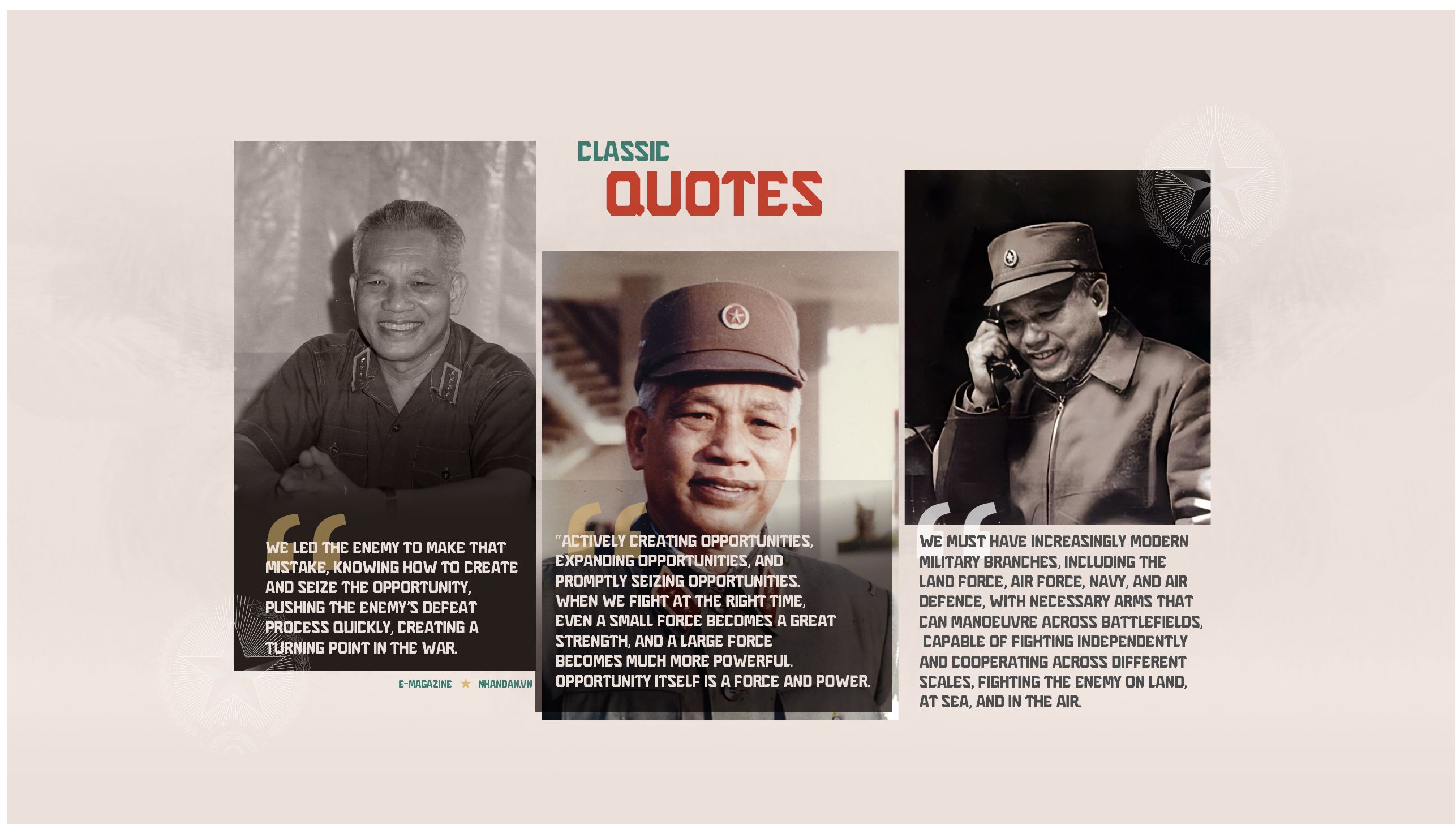
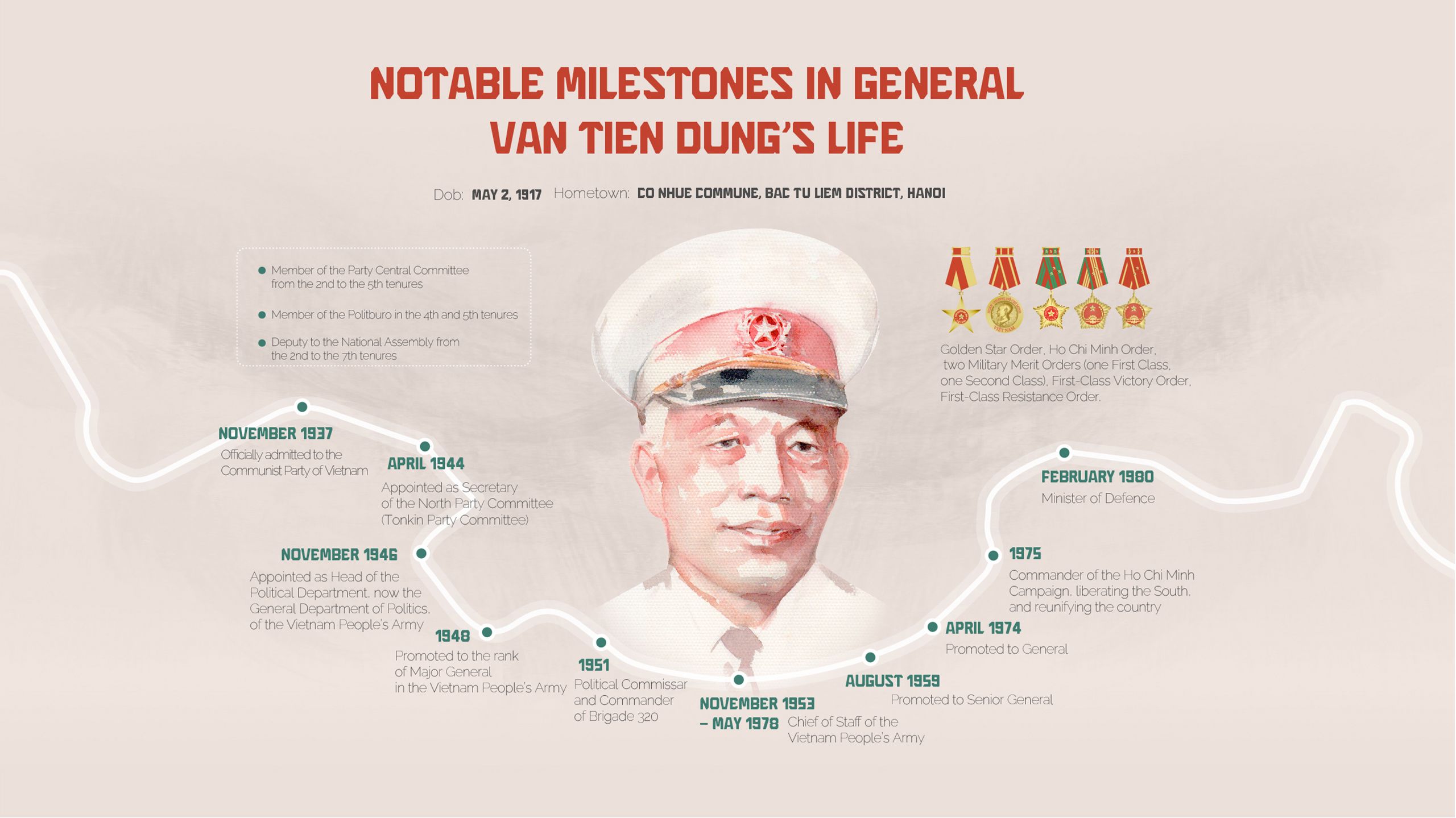
Comments about General Van Tien Dung
Classic quotes
Published: December 2024
Content: Captain, Master Nguyen Ngoc Toan, Institute of Military History
Translation: NDO
Photos: Vietnam People’s Army, VNA
Illustration: Hoang Tuong
Design: Ta Lu - Pham Son

